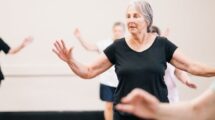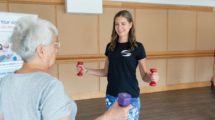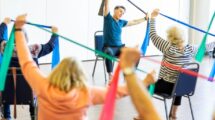Disproving the myth that you have to sow in agony to reap benefits from physical activity
By Jacqueline Ruck
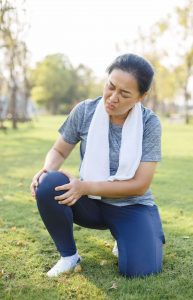
We’ve all heard the phrase, “no pain, no gain,” and many of us have likely applied this old adage to our workout routines. We’ve been programmed to think that if our heart rate isn’t through the roof and our muscles aren’t begging us for mercy as the sweat pours down our brow, we probably aren’t pushing ourselves hard enough. This mentality has led many of us to believe that there is no point in even attempting to exercise unless we are prepared to punish our bodies in the name of fitness.
The reality is that “no pain, no gain” isn’t necessarily true. Exercise is not always comfortable and should require exertion, but it is possible to gain a great deal from your workout without causing yourself pain. In fact, if your body is experiencing intense pain due to your workout, as opposed to fatigue or soreness, you may be doing something wrong. Below are tips on how to decrease the risk of pain induced by exercise while maximizing what you gain.
Dress the part
Suiting up to work out is not just about looking good. The proper clothing, shoes, padding, etc., can all affect how safe and effective your workout will be. The footwear you choose can have a direct correlation to the amount of pain you feel during and after your physical activity. For example, running in shoes that don’t fit your feet, or aren’t designed for this particular type of movement, can cause you to experience much more pain than you would experience with the proper footwear. Choosing a shoe/sneaker that best suits the physical activity of your liking is an investment you won’t regret. A sales associate in any sporting goods store should be able to help you find your perfect fit.
Once you find the perfect footwear, choose clothing that provides comfort while you train. Clothing that breathes, or absorbs sweat, can prevent your body from overheating. And your outfit should never hinder your exercise. Clothing that stretches and allows your body to have a full range of motion is key to ensuring that your workouts are performed properly.
Finally, some workouts call for safety gear such as helmets, shin, or kneepads. This type of gear allows you to give your all during your activity without the fear of unnecessary cuts, bruises, or something more serious such as a head injury.
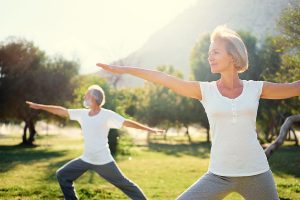
Warm-up
Warming up your body before you exercise is an important habit to form. As we age, our joints can lose flexibility, and our bodies may be prone to a greater risk of injury while exercising. But injury is not inevitable. By gradually increasing intensity as we work out, we are giving the heart time to grow accustomed to greater movement while increasing circulation throughout the body. Your warm-up should go hand in hand with your workout. If you plan on running, ensure that you have properly warmed up before you begin. This could be as easy as jumping on a stationary bike for a few minutes and gradually increasing your speed. If you are lifting hand weights, make sure that your arm muscles are ready to lift. This can be achieved by doing large arm circles or lifting a lighter weight than the one you will be using during your workout. A proper warm-up can assist you in receiving all the benefits that come from exercising without injuries or improper strain on your body.
Stretch it out
Stretching can be performed as part of your warmup, so long as it’s the proper type of stretch. Dynamic stretching involves continuous, controlled movements such as arm circles or walking lunges and is an excellent way to warm up your body. It is useful in releasing the tension in your muscles and, as a result, reduces the pain that can come from working out, as well as the risk of injury. It is also important to stretch your muscles after you do any type of physical activity. This allows blood to flow more freely to your muscles, thereby decreasing the risk of pain and creating greater flexibility in your joints. Static stretches are slow movements that are held for 30-40 seconds at the end of the stretch. This type of stretch should be part of your cool down. An example of a static stretch is to sit on the floor with your legs spread apart in a split position. Slowly stretch one arm as close to your foot as possible and hold that position for 30-40 seconds. Remember, stretching should feel good and should act as a reward after a workout! Do not stretch to the point of pain.
Take a break
The myth that the more you work out, the greater shape your body will be in is just that: a myth. Resting is just as important as being active. Constant exercise is detrimental to your nervous system and can lead to injury and illness. There should be no guilt when it comes to taking days off from physical activity. Mental stress can cause physical illness, and the same effect can occur due to physical stress.
Putting too much strain on your body causes it to stress out. You must give your muscles time to repair if you want to see results. This doesn’t mean that in order to rest, you have to sit on the couch, avoiding all movement. On your day of rest, you might consider taking a walk around your neighborhood or doing some other form of light physical activity that allows you to fill your lungs with oxygen without raising your heart rate as much as you would during a workout.
Getting enough sleep is also important when focusing on maintaining a healthy lifestyle. If you’re sleep-deprived, it will be very difficult to have a successful workout. Following your exercise, your body is deserving of proper rest and your mind of a chance to unwind.
Choosing the right footwear to meet your needs
The running shoe
A running shoe is designed specifically for running and should not be used for other forms of activity. The heel of a running shoe is generally thicker and designed to protect your joints against the continuous pounding of your feet against the ground. Running shoes also tend to have more cushioning than other types of footwear. If speed is your goal, choose a shoe that is lighter and designed specifically for racing, such as a racing flat. This will not prevent injury the way typical running shoes will, so unless the need for speed is crucial, you will want to stay away from these. Also, consider what type of surface you will be running on. If you’re running on rough terrain, purchase a shoe that has grips specifically designed for a rocky surface. Runners tend to try out many different shoes before finding the perfect one for them, but it is well worth the effort.
The cross trainer
Cross trainers are designed for versatility, and as a result, many people gravitate to this sneaker. But they do not provide the flexibility and cushioning needed to run or perform other high-impact exercises. They are useful for the individual who works out at the gym and is constantly switching machines. The cross trainer will carry you through a light jog on the treadmill, to some weightlifting followed by ab workouts on a mat. They tend to be more economical than more specialized footwear.
The walking-shoe
Walking shoes should be flexible and able to follow your foot as it makes a heel-to-toe motion. This flexibility will protect against injuries such as shin splints. Because your heel hits the ground first when you walk, the heel of a walking shoe should be flat. Running shoes tend to have a higher heel, and for this reason, they can be dangerous to use for walking. For speed walking, you will want to choose the most flexible walking shoe you can find. In some cases, lightweight running shoes may even be appropriate for speed walking.
General rules
While exercising, your feet can expand as much as one size larger than their usual size. For this reason, when purchasing footwear of
any kind, you should head to the store in the afternoon when your feet are their largest. Bring the type of socks you will use during your workout to ensure that you find the perfect footwear for your needs. Sources:10Tips for Exercising Safely, Harvard Health Publications,
health.harvard.edu/healthbeat/10-tips-for-exercising-safely



